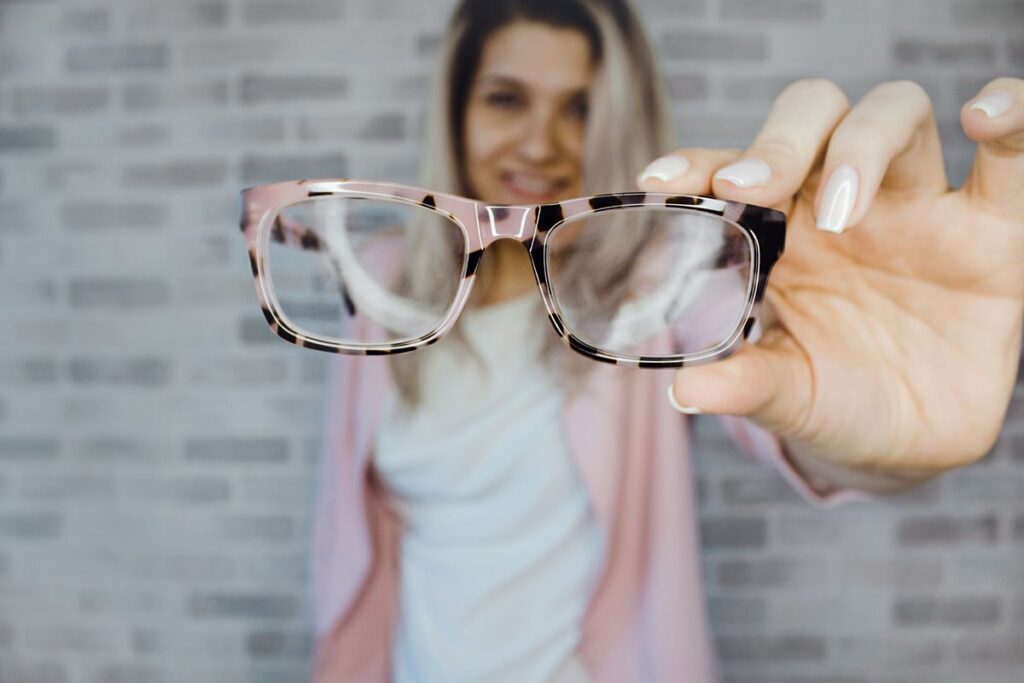The article ‘Maximizing Vision: Advances in Precision Eyewear Measurement’ delves into the remarkable advancements in eyewear technology that have revolutionized the way vision correction is approached. It explores the evolution from traditional methods to cutting-edge digital techniques, ensuring that eyeglasses and contact lenses are not only corrective but also comfortably tailored to individual needs. This personalized approach to eyewear design and manufacturing promises enhanced visual clarity, superior comfort, and a seamless integration with the wearer’s lifestyle.
Key Takeaways
- Precision in eyewear measurement has transitioned from subjective refraction to advanced digital techniques, enabling more accurate and individualized vision correction.
- Digital imaging and scanning technologies have facilitated the creation of eyewear that is custom-fitted to the wearer’s unique ocular characteristics, improving comfort and vision.
- Theoretical models complement clinical insights in lens design, offering a balance between highly controlled simulations and real-world variability.
- Optician expertise in frame and lens selection is crucial for optimizing vision correction while considering aesthetics and specialized treatments.
- Innovations in contact lens manufacturing, such as customized design and the achievement of complex geometries, have significantly enhanced wearer comfort and visual acuity.
The Evolution of Precision Measurement in Eyewear

Historical Perspectives on Peripheral Optics Research
The quest to understand and measure the peripheral optics of the eye has been a complex journey, beginning over two centuries ago. Early methods, such as subjective refraction, were heavily dependent on patient feedback and lacked the precision needed for accurate assessment. Retinoscopy, another historical technique, faced challenges in repeatability and required a high level of skill from the examiner due to the irregular shape of the off-axis pupil.
In recent years, advancements have led to a variety of methods for peripheral refraction. These include techniques that evaluate the refractive state directly and those that analyze the complete optical aberration profile. The table below summarizes the evolution of measurement techniques:
The refinement of measurement techniques has been instrumental in enhancing our understanding of peripheral vision and its impact on overall visual function.
The integration of modern technology has allowed for more sophisticated approaches, such as the use of theoretical lens designs to predict visual outcomes. These advancements pave the way for future innovations in eyewear, including the potential for adaptive prescriptions and smart integration, as highlighted by Optigrid’s vision for personalized vision solutions.
The Shift from Subjective Refraction to Digital Precision
The transition from traditional subjective refraction methods to digital precision has marked a significant milestone in the field of eyewear measurement. Digital techniques now offer a more objective and repeatable assessment of the eye’s refractive state, overcoming the limitations of patient-dependent subjective refraction and the lack of repeatability in retinoscopy.
Digital precision in eyewear measurement has enabled the capture of the complete optical aberration profile, providing a comprehensive understanding of the eye’s refractive needs.
The advent of digital tools has not only improved the accuracy of measurements but has also streamlined the process, making it more accessible to clinicians and patients alike. Below is a list of key advancements in digital measurement techniques:
- Introduction of wavefront aberrometry for detailed aberration analysis
- Development of automated refractors to reduce human error
- Utilization of corneal topography for precise curvature mapping
- Implementation of 3D eye modeling for custom lens design
These advancements have paved the way for a new era in precision eyewear, where lenses are tailored to the individual’s unique ocular characteristics, enhancing both vision and comfort.
Challenges and Solutions in Measuring Complex Lens Designs
The quest for precision in eyewear necessitates overcoming the inherent challenges of measuring complex lens designs. Consistent measurement within the pupil is critical for the accuracy of multifocal lenses, which often feature concentric rings or power discontinuities. Experts have found that avoiding measurements through these lenses and instead measuring the eye without a contact lens (CL) can sidestep these issues. However, recent advancements have shown that accurate measurements are possible with careful attention to consistency.
The integration of advanced optical modeling and clinical research is pivotal in refining lens designs and enhancing visual acuity.
To ensure precision, several solutions have been proposed:
- Utilizing adaptive optics systems to assess visual acuity through theoretical lens designs.
- Employing theoretical eye models to provide specific inputs for direct comparisons of lens designs.
- Evaluating lens rotation with a slit-lamp beam and an integrated protractor gauge.
- Manual rotation of lenses to measure the time for re-alignment or recovery after blinking.
These methods, while less realistic than on-eye clinical measurements, offer a structured approach to lens optimization. Further research is necessary to fully understand the potential of these techniques and to integrate human factors variability.
Personalized Fit: The Digital Revolution in Eyewear Customization

Capturing Unique Ocular Parameters for Custom Fit
The advent of digital measurement technologies has revolutionized the way eye care professionals approach eyewear customization. Precise digital measurements are now fundamental in capturing unique ocular parameters, ensuring that each pair of glasses or contact lenses is tailored to the individual’s specific needs. This personalized approach goes beyond mere prescription strength, considering factors such as pupillary distance, dominant eye characteristics, and lens-to-eye spacing.
- Digital imaging and scanning techniques are employed to map the eye’s surface and gather essential data.
- Advanced calibration methods, like the 14-dot calibration interface, provide high granularity for precise fitting.
- The collected data informs the customization of lens design, from curvature to thickness, for optimal visual performance.
The result is eyewear that offers maximized visual clarity, comfort, and a distinctive design that complements the wearer’s unique features.
This meticulous process of capturing and utilizing ocular parameters is a testament to the commitment to providing a truly custom fit. It’s a process that not only enhances the wearer’s vision but also contributes to the overall satisfaction and experience with their eyewear.
The Role of Digital Imaging in Tailored Lens Fabrication
The eyewear industry embraces tailored solutions with the integration of digital imaging, revolutionizing the way lenses are designed and fabricated. This technology not only enhances the precision of lens measurements but also allows for the creation of complex geometries that cater to the unique visual needs of each individual.
Digital imaging and scanning techniques are pivotal in achieving a personalized fit. They enable the capture of intricate ocular parameters that are essential for crafting lenses that provide superior comfort and visual acuity. The process involves several steps:
- Capturing detailed 3D scans of the eye.
- Mapping the corneal shape and other critical features.
- Utilizing advanced algorithms to translate the data into a lens design.
- Rapid prototyping and iteration to refine the lens for optimal performance.
The advent of these technologies has not only accelerated the design process but also opened up possibilities for innovative lens functionalities. Customized designs, such as multifocal and toric lenses, are now more accessible, providing therapeutic benefits alongside enhanced vision.
Efficient prototyping and rapid iteration are other key advantages brought about by digital imaging. These processes allow for quick adjustments and enhancements, ensuring that the final product meets the wearer’s expectations for both aesthetics and functionality.
Advancements in Pupillary and Peripheral Vision Measurements
Recent advancements in the field of eyewear measurement have significantly improved our understanding and capabilities in assessing pupillary and peripheral vision. The integration of digital imaging and advanced optical aberration profiling has revolutionized the precision of these measurements.
Traditional methods such as subjective refraction and retinoscopy, while foundational, often lacked repeatability and required highly skilled examiners. Modern techniques, however, offer a more reliable and comprehensive analysis of the eye’s optics, extending up to 40 degrees of peripheral vision.
Despite these technological strides, challenges persist, particularly when measuring lenses with rapid power changes or discontinuities. Experts recommend caution in such cases to ensure accuracy.
The table below summarizes the range of vergences used in visual acuity testing, reflecting the precision now achievable in pupillary and peripheral vision measurements:
These advancements not only enhance the accuracy of vision correction but also contribute to the development of more effective and comfortable eyewear, tailored to the unique ocular parameters of each individual.
Optimizing Lens Design Through Theoretical Models and Clinical Insights

Exploring the Impact of Spherical Aberration on Vision
Spherical aberration is a high-order aberration that can significantly affect visual performance, particularly under conditions of larger pupil sizes and reduced lighting. While some lenses are designed to minimize the occurrence of spherical aberration, others are engineered to counterbalance the eye’s inherent aberration, enhancing distance vision for many wearers. The impact of spherical aberration is not uniform; it varies with the focusing ability of the eye and among individuals.
The average human eye exhibits positive spherical aberration, which can be offset by certain lens designs. However, misalignment of the lens with the cornea, especially concerning the center of the pupil, can introduce other aberrations, complicating the correction process.
The table below summarizes the relationship between lens power and spherical aberration, highlighting the complexity of achieving optimal vision correction:
Understanding and correcting for spherical aberration is crucial in the development of precision eyewear. Advanced technologies, such as revolutionary eyeglasses fitting software, are aiding optometrists in creating lenses that not only correct for refractive errors but also account for individual aberrations, ensuring a personalized and enhanced visual experience.
Theoretical vs. Clinical Approaches to Lens Optimization
In the quest for the perfect lens, the eyewear industry often navigates between the precision of theoretical models and the practical insights of clinical research. Theoretical models provide a controlled environment to test and compare different lens designs, such as monofocal or multifocal lenses, by simulating visual acuity through various optical configurations. For example, adaptive optics systems can generate theoretical data to predict how lens designs might affect vision at different distances.
Clinical approaches, on the other hand, take into account the real-world variability of human eyes. These methods involve on-eye measurements and trials to assess how actual wearers perceive changes in lens design. The data from clinical studies is invaluable for understanding the nuances of vision correction in diverse populations.
The integration of theoretical and clinical data is crucial for optimizing lens designs that cater to individual needs.
While both approaches have their merits, the eyewear industry is increasingly leveraging technology to bridge the gap. Revolutionary eyeglasses software that integrates AI for personalized recommendations is a testament to this synergy. Systematic trials continue to validate optical technologies, including the use of optical vortices to enhance vision in prescription glasses. The Vision Pro software is a prime example of how real-world applications are revolutionizing eye care with clear vision.
Future Directions in Lens Design Research
The relentless pursuit of perfection in lens design is poised to harness the potential of nanotechnology, promising lenses with superior surface properties and functionality. Nanotechnology could revolutionize lens surfaces, enhancing wettability and introducing antimicrobial features, thereby elevating wearer comfort and safety.
The synergy between advanced fabrication techniques and theoretical insights is expected to yield unprecedented customization in lens design, catering to the unique visual needs of each individual.
The table below outlines potential advancements and their impact on lens design:
As we look to the future, the integration of clinical insights with cutting-edge technology will continue to drive the evolution of lens design, ensuring that precision and personalization remain at the forefront of ocular health and vision enhancement.
Strategic Consultations for Enhanced Vision and Aesthetics

Balancing Prescription Power with Face Shape and Design
Selecting the ideal frame for prescription eyewear is a nuanced process that involves harmonizing the prescription power with the wearer’s facial features. The right frame not only corrects vision but also complements the individual’s face shape and aesthetic preferences.
- Oval Face: Versatile in frame choice, including circular and square frames.
- Square Face: Benefits from round or oval frames that soften angles.
- Heart Face: Flattered by cat-eye glasses or frames wider at the top.
- Oblong Face: Frames with more depth and decorative temples balance the face.
- Diamond Face: Oval or cat-eye frames enhance cheekbones.
Frames should sit comfortably on your nose bridge and align with your eyes without touching your cheeks or eyebrows. Consideration of lens thickness is crucial for those with strong prescriptions to ensure the frames accommodate the lenses aesthetically.
Seeking professional advice is key to achieving the perfect fit and look. An expert can guide you through the myriad of options and help you find a frame that not only suits your prescription needs but also enhances your natural features and personal style.
The Importance of Optician Expertise in Frame Selection
The role of a licensed optician extends beyond mere measurements; it encompasses a deep understanding of how frames interact with the wearer’s facial features, lifestyle, and vision needs. Opticians recommend frames that not only correct vision but also enhance the wearer’s overall appearance and comfort. They consider factors such as face shape, prescription strength, and personal style to suggest the most suitable options.
- Frame customization involves selecting the ideal size, shape, material, color, and pattern to complement facial features and reflect personal aesthetics.
- Professional examinations and consultations are critical to ensure that the frames align perfectly with the wearer’s vision requirements and facial structure.
- Opticians also play a crucial role in ensuring that the lenses are compatible with the frame, particularly for high prescriptions where lens thickness can affect the frame’s fit and aesthetics.
The process of selecting the right eyewear is a blend of art and science, requiring a meticulous balance between functional vision correction and personal expression. The expertise of an optician is invaluable in achieving this harmony, ensuring that the eyewear not only serves its purpose but also becomes an integral part of the wearer’s identity.
Addressing Specialized Treatments and Versatility in Eyewear
In the realm of eyewear, the need for specialized treatments and versatility cannot be overstated. Customized and specialty lenses have become a cornerstone of modern optometry, catering to a diverse range of visual impairments and lifestyle requirements. From reducing glare for night driving to enhancing contrast for those with macular degeneration, the options are extensive and personalized.
For patients with specific conditions such as diabetic retinopathy or retinitis pigmentosa, the integration of advanced lens technologies is crucial. These may include:
- Aspheric and atoric designs to reduce aberrations
- Multifocal lenses for presbyopia
- Customized lenses for irregular corneas
Embracing a multidisciplinary approach not only enhances patient care but also bolsters the reputation of the practice. It necessitates robust software integration to manage the complex data involved in crafting these precision treatments.
The versatility of eyewear today extends to frame styles as well, with options ranging from pediatric frames to fitover and wrap-around frames, ensuring comfort and protection for every face shape and need. The selection process is a delicate balance between prescription power, aesthetic preferences, and the functional demands of the wearer’s lifestyle.
Innovations in Contact Lens Manufacturing for Superior Comfort and Vision

Customization and Personalization in Contact Lens Production
The landscape of contact lens production has been transformed by the integration of advanced mapping and imaging technologies. These innovations have paved the way for lenses that are not just corrective, but also uniquely tailored to the individual’s corneal shape and visual requirements. The advent of 3D printing in the contact lens industry has been particularly revolutionary, enabling the creation of lenses that offer a personalized fit and enhanced visual performance.
The process of contact lens production has evolved to prioritize both precision and personalization. This evolution reflects a broader trend in eyewear, where the convergence of health monitoring and bespoke fashion is becoming increasingly prominent.
The lathe-cutting technique, while traditional, continues to be a cornerstone in the production of specialized or custom lens designs. It exemplifies the industry’s commitment to precision, even as newer technologies emerge to streamline production and expand capabilities. The following points highlight the key benefits of these advancements in contact lens manufacturing:
- Customized design and personalization through digital imaging and scanning.
- Achievement of complex geometries and surface textures for innovative lens functions.
- Efficient prototyping and rapid iteration, propelling design advancements and patient satisfaction.
Achieving Complex Geometries for Advanced Lens Functions
The advent of sophisticated manufacturing technologies has been pivotal in the creation of contact lenses (CLs) with complex geometries. These innovations have significantly improved optical performance, offering wearers enhanced visual clarity and comfort. The ability to produce aspheric and atoric designs, which reduce aberrations, is a testament to the precision achievable in modern lens fabrication.
The integration of 3D printing and CNC lathing has revolutionized the production of CLs, allowing for rapid prototyping and the creation of lenses with intricate surface textures.
Advanced designs such as multifocal and accommodating lenses cater to a wide range of visual impairments, including presbyopia, by providing seamless transitions between different focal points. Moreover, customized lenses for irregular corneas ensure a comfortable fit tailored to individual ocular characteristics.
Innovative techniques like nanotechnology and microfluidics have further expanded the possibilities, enabling the creation of lenses with micro-scale structures that were once impossible to achieve. These advancements not only enhance the wearer’s experience but also open up new avenues for therapeutic applications.
The Future of Contact Lens Technologies and User Experience
The digital revolution in optical care is set to transform the contact lens industry with a focus on user experience and advanced technologies. Innovations such as silicone hydrogel lenses, hybrid materials, and 3D printing are already making waves by offering superior comfort and oxygen permeability. These advancements not only improve vision correction but also address historical limitations of contact lenses.
The integration of AI and smart eyewear into contact lens technology heralds a new era of personalized optical care. This approach promises to enhance efficiency, profitability, and patient engagement.
Further developments are anticipated in the realms of material biocompatibility, real-time discomfort monitoring, and lubrication strategies. The pursuit of these innovations reflects a commitment to not just meet but exceed patient expectations for comfort and visual clarity. The table below summarizes the key areas of focus for future contact lens technologies:
As we look to the horizon, the contact lens industry is poised for a transformative leap, driven by a synergy of clinical insights and cutting-edge research.
The realm of contact lens technology is constantly evolving, with groundbreaking advancements like OPTIGRID paving the way for lenses that offer unparalleled comfort and crystal-clear vision. These innovations are not just enhancing the user experience but are also setting new benchmarks in the industry. To discover the full spectrum of benefits that these cutting-edge contact lenses can offer, visit our website and explore a world where eye care meets innovation. Don’t miss out on the opportunity to elevate your vision to the next level.
Conclusion
The journey through the landscape of precision eyewear measurement reveals a harmonious blend of technology and personalized care. From the meticulous capture of exact measurements to the integration of advanced digital tools, the evolution of eyewear is marked by a relentless pursuit of perfection. As we’ve explored, the precision in measurement not only enhances visual clarity but also ensures comfort and style for the wearer. The challenges of measuring complex lens designs and peripheral vision have been met with innovative solutions, and the potential for future advancements promises even greater customization and satisfaction. The collaboration between eye care professionals and technological advancements underscores a future where eyewear is not just a corrective tool, but a tailor-made enhancement to our visual experience. As we continue to push the boundaries of what’s possible, the vision of precision eyewear measurement stands as a testament to the ingenuity and dedication of those committed to maximizing our sight.
Frequently Asked Questions
How has the evolution of precision measurement impacted eyewear?
The evolution of precision measurement in eyewear has led to more accurate and personalized vision correction. By capturing exact measurements for ideal alignment and utilizing digital tools, eyewear can now grant maximized visual clarity, comfortable wearability, and versatility across activities.
What are the challenges in measuring complex lens designs?
Measuring lenses with rapid power changes or power discontinuities presents challenges. Accuracy concerns arise with instruments measuring multifocal lenses, leading some experts to suggest avoiding such measurements and focusing on single-vision lenses instead.
How do digital measurements enhance the fit of eyewear?
Digital measurements enhance eyewear fit by capturing multiple eye measurements related to the frame and lens, including precise pupillary location, spacing between eyes, and personalized prescription placement. This ensures a more customized fit compared to a one-size-fits-all approach.
What is the difference between theoretical models and clinical approaches to lens optimization?
Theoretical models use simulations and predefined ocular parameters to explore and optimize lens designs, while clinical approaches involve real-life measurements and account for human variability. Theoretical models provide specific inputs but lack the realism of clinical measurements.
What advancements have been made in contact lens manufacturing?
Advancements in contact lens manufacturing include the ability to customize design and personalization through digital imaging, creation of complex geometries for innovative lens functions, and rapid prototyping for design advancements, all contributing to enhanced vision and comfort.
How do consultations contribute to the selection of eyewear?
Consultations with eye care professionals are crucial for selecting frames and lenses that balance prescription power with face shape and design. Expertise in frame selection and addressing specialized treatments ensure that the eyewear not only corrects vision but also complements the wearer’s aesthetics.

I am a seasoned software engineer with over two decades of experience and a deep-rooted background in the optical industry, thanks to a family business. Driven by a passion for developing impactful software solutions, I pride myself on being a dedicated problem solver who strives to transform challenges into opportunities for innovation.
